St. Louis, Missouri and Illinois
St. Louis is one of the great historic metropolises of the USA which were developed in the 19th century while gradually settling the Western plains of the American continent.
Mississippi River which straddles the city served as a premodern freight highway. Industry developed along it attracting European migrants, including Lithuanians.
East St. Louis Lithuanian church
Church of Immaculate Conception at East St. Louis (1509 Baugh Ave) is one of the best examples of Lithuanian-American national romantic architecture. It has been designed by Jonas Mulokas, its stained-glass windows created by Vytautas Kazimieras Jonynas (year 1956), for whom it was the first such major work. Together, these two authors created the post-WW2 style of Lithuanian churches where they sought to represent their lost homeland as best as they could (after all, the post-WW2 migrants have been forced from their country by Soviets rather than emigrating on their own will).
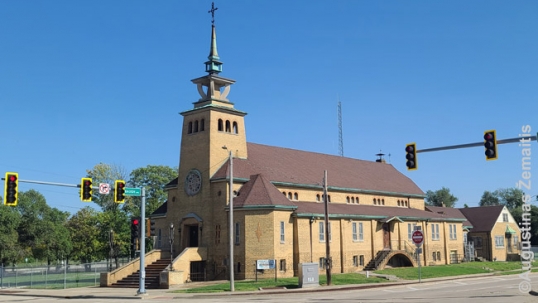
Immaculate Conception Lithuanian church of East St. Louis
The forms of the church aren't resembling any single historical style but they are not modern either. Even the Christian church elements have been "ethnicized" here: the cross is mixed in form with sun and moon (inspired by peasant or even pagan Lithuanian symbolism), the front side has bas-reliefs in the form of crosses of Vytis and towers of Gediminas, the main entrance incorporates Vytis, while the tower is inspired by Baroque although not copying it directly (this is symbolic as at the time Baroque was regarded to be the most Lithuanian of Western styles due to its prevalence in Vilnius church architecture). There are ethnic wooden carvings above doors.
Inside, the altar is also decisively ethnic Lithuanian, carved from wood (author Petras Vėbra).
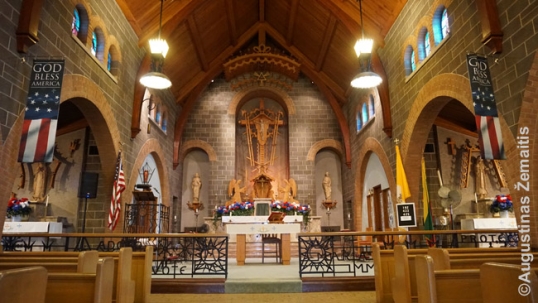
The interior of the church with a Lithuanian-folk-woodcarving altar
The most striking parts of the interior are 55 stained glass windows, most of which have Lithuania-related topics. The southern wall is adorned by 8 stained-glass windows of Mary-related places of Lithuania, with reimaginations of the local paintings of Mary in the foreground and famous buildings in the background (the northern wall is likewise covered with 8 windows with Maryan sites outside Lithuania). There are also historical scenes, such as the Baptism of Mindaugas (first king of Lithuania).
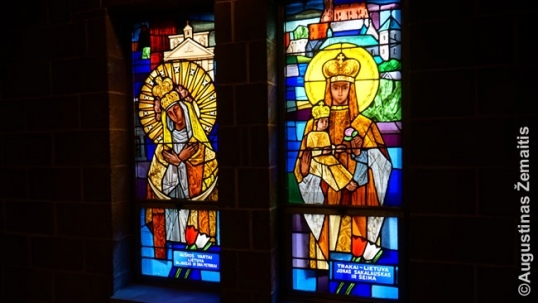
Stained glass windows of the Virgin Mary of the Gate of Dawn (vilnius, left) and the miraculous Virgin Mary of Trakai (right)
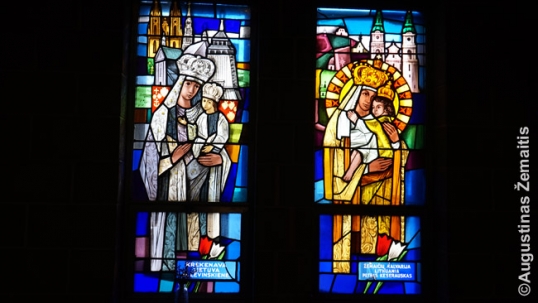
Stained glass windows of the Virgin Mary of Krekenava (left) and the Virgin Mary of Žemaičių Kalvarija (right)
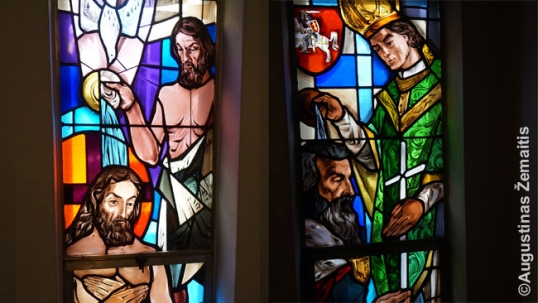
Baptism of Jesus (left) compared to Baptism of King Mindaugas (right). While Baptism of Jesus may be seen as the beginning of the worldwide Christian community, the baptism of Mindaugas began the Lithuanian Christian community and, according to some interpretations, the Lithuanian nation
Especially related to Lithuania are the stained-glass windows in the top arches, where historical Lithuanian personalities (both religious and secular) and coats of arms of the Lithuanian cities are presented. There you may find images of the Patron of Lithuania St. Casimir, first king Mindaugas, the "national poet" Maironis, grand duke Vytautas (who expanded Medieval Lithuania the furthest), an activist against Russification of Lithuania bishop Motiejus Valančius, the founder of Vilnius University Protasevičius.
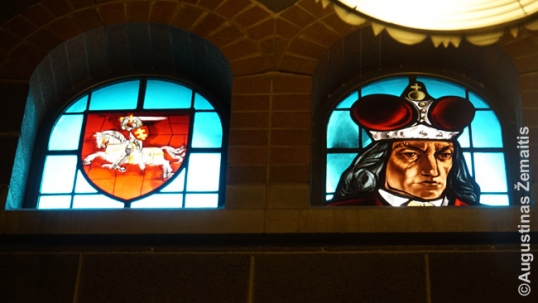
Stained glass windows of Vytautas the great (right) and the Lithuanian Coat of arms (left) by V. K. Jonynas
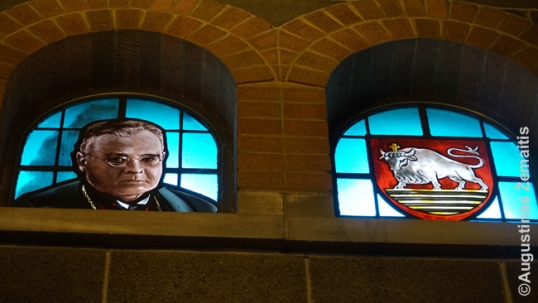
Stained glass windows of the national poaet Maironis (left) and the Kaunas city coat of arms (right) by V. K. Jonynas
There are so many ethnic Lithuanian details that it is impossible to list every single one and the church could serve as a kind of repository of the Lithuanian history, as nearly every wooden or metal decoration follows a Lithuanian folk pattern or design, or uses the traditional Lithuanian symbols.
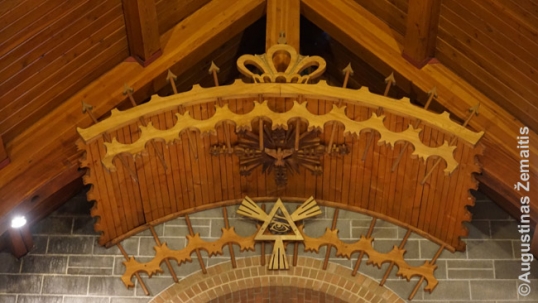
Lithuanian ethnic woodcarving inside the East St. Louis church

The front wall of the church includes two traditional Lithuanian crosses f Vytis (in darker bricks), two Columns of Gediminas (in darker bricks, on the corners), while the door has a metal image of the Lithuanian Coat of Arms
The parish is much older than the church itself, established in 1895. Its first church has been constructed in 1897, enlarged in 1928 and destroyed by fire in 1943.
Since the year the current church was built East St. Louis became an infamously unsafe district, declining in population from ~80 000 to ~20 000. Despite that, the church remained open, even though 11 of 13 Catholic churches in the area have been closed by 2018. Its location next to a highway attracts attention and even new parishioners, as the members of the parish have told "Global True Lithuania". Nevertheless, the church also had some problems: two of the Lithuanian sun-crosses that have adorned the roof had to be removed after there was an attempt to steal them and put in a safer place near the basement stairs. In the basement, one can find a parish hall where the Lithuanian activities, as well as post-Mass events, take place, as well as a small parish museum. There, you can also see the images of the way the church had to look like as designed by an American architect L. Prens. While even that design included some Lithuanian features (as was likely requested by the Lithuanian parish and its then-pastor Deksnys), altogether it looked much more like a regular church of the era. Architect Prens died, however, and the order has been entrusted to Mulokas and Jonynas who ethnicized the entire design of the church. Only the basement (opened in 1945 as a church while construction continued) was built according to the Prens design.
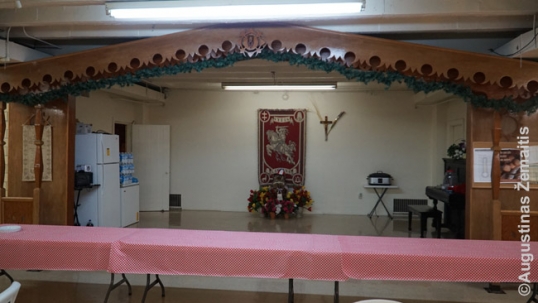
Lithuanian details in the church basement that now serves as a hall for after-mass socialization, including the Lithuanian activities
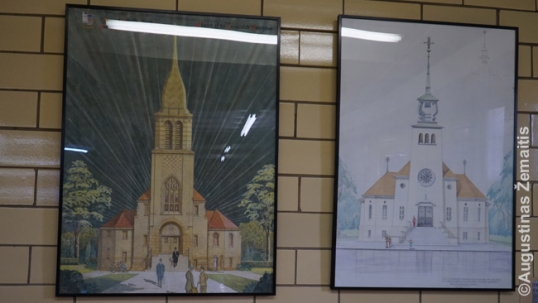
The original project of the church by Prens (left) and the altered one by Mulokas (right)
East St. Louis Immaculate Conception church looks is similar to the All Saints Lithuanian church in Chicago and also has similar elements to the Nativity BVM church of Chicago (the last of them being created by the same tandem of designers).
In the empty lot next to the East St. Louis Lithuanian church, a Lithuanian school used to stand. It was opened in 1934, closed in 1968 and burned (arson suspected) in 1976.
Between the former school and church, a sculpture of Our Lady of Šiluva was erected in 1951, which still stands. Rituals of crowning the sculpture used to be performed by the schoolchildren.
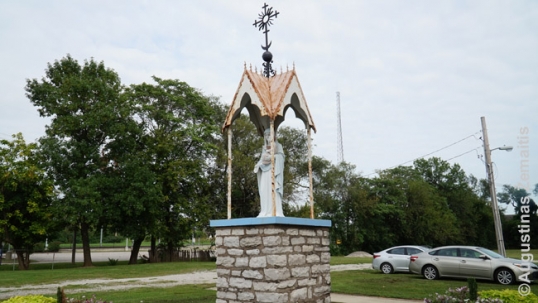
Our Lady of Šiluva shrine, covered by a traditional Lithuanian metal cross of the type common at the historic Lithuanian cemeteries (especially in Lithuania Minor)
Collinsville and its Lithuanian Lutheran church
Further east the suburb of Collinsville has a small white church built by Lithuanian Lutherans in 1903, known as the Jerusalem Lutheran church (305 Collinsville Ave).
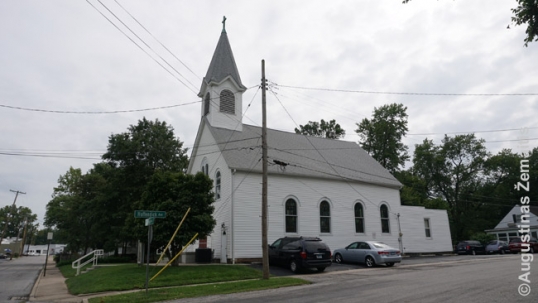
Collisville Jerusalem Lithuanian Lutheran church
This is one of merely 3 Lithuanian Lutheran churches in the USA, two other ones standing in Chicago. The building is small and wooden. It still has Lithuanian names of the sponsors inscribed on its stained glass windows, among them "Shimkus" (possible relatives of the US congressman Shimkus).
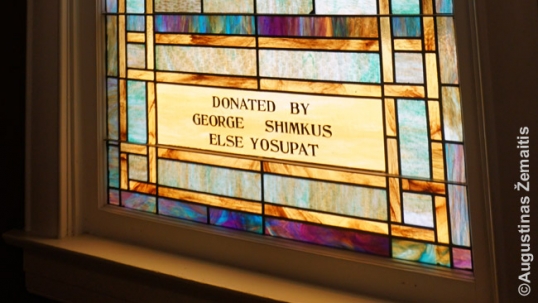
Stained-glass windows inscriptions with Lithuanian names at the Collinsville church
The church has been also organized by the victims of Russian occupation but the earlier Imperial (1795-1915) rather than the Soviet one (1940-1990). The pastor Keturakaitis who established this church previously worked as book smuggler in Lithuania, importing Lithuanian books into Russian-occupied Lithuania at the time the Russian regime banned Lithuanian language (he had served a prison term for that). In Lithuania, he lived in Tauragė, an area that used to be near the border of the Russian and German empires and had many Lutherans. It was precisely the Lutheran areas of Lithuania that gave most emigrants for the Collinsville coal mines and even before Keturakaitis came, they used to have Lutheran worship in their homes or other churches.
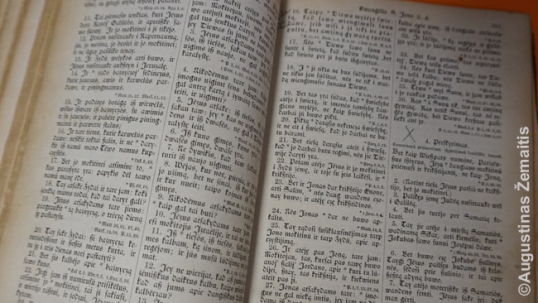
A fraktur-script book at the Jerusalem Lithuanian Lutheran church at Collinsville. Fraktur used to be used in Lithuania Minor where most Lutheran Lithuanians lived, while the traditional Latin scipt was used by Catholic Lithuanians. After the Soviet genocide has wiped out the Lithuania Minor in the 1940s, Latin script became the sole remaining script in use among Lithuanians, making this book hardly readable to modern-day Lithuanian Lutherans
The parish reached the high point after World War 2, when the community has sponsored arrival of the refugees from Lithuania who fled the Soviet occupation. Most refugees sought that the church would become associated with the Lithuanian Lutheran church, however, while many older parishioners preferred a continuing Missouri Synod affiliation, leading to a dispute among the "old" and "new" parishioners. The dispute ended up in favor of Missouri Synod; however, most of the proponents of the Lithuanian Lutheran church then left the parish, attending only the ethnic Lithuanian but not the religious festivals. Some of them still supported the parish, though, but the number of parishioners declined since, although non-Lithuanians sometimes joined.
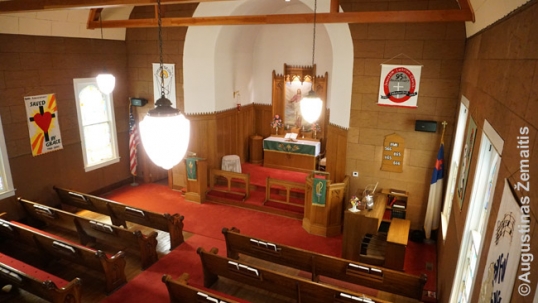
Collinsville Lithuanian church interior
Even though in the 2000s only some third-to-half of the congregation was of Lithuanian heritage, the parish sponsored a construction of a Lutheran church in Palanga, Lithuania then.
Lithuanian heritage in downtown St. Louis
St. Louis metropolis straddles across two states as the Missouri/Illinois borderline here follows the Mississippi River. Both the aforementioned Lithuanian communities are located on the Illinois side but the Missouri side (which also has the St. Louis downtown) also had its own Lithuanian church dedicated to St. Joseph, acquired from Protestants in 1916 in the historic Lafayette Square district famous for its turn-of-the-century architecture (address: corner of Park Avenue and MacKay Place). Small, looking as if built of stones, the church has been closed in 1970 when Lithuanians left the then-poor neighborhood.
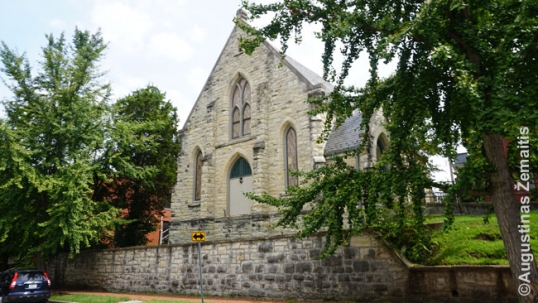
St. Joseph Lithuanian church at St. Louis, Missouri
St. Louis is also famous for its City Museum. For kids, it may seem to be a large playground while for adults, it is a work of art and a memorial for the declining American cities. Much of its interior is filled with the details of demolished pretty buildings and closed institutions. Among the main details is the St. George bas-relief that used to be above the main entrance to the Chicago St. George Lithuanian church, demolished in 1990.
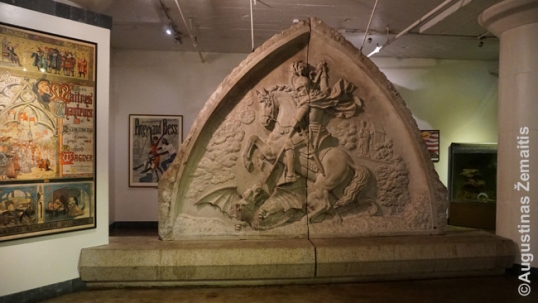
St. George bas-relief of Chicago St. George Lithuanian church at the City Museum of St. Louis, Missouri

City Museum at St. Louis, Missouri
The map
All the Lithuanian locations, described in this article, are marked on this interactive map, made by the "Destination Lithuanian America" expedition (click the link):




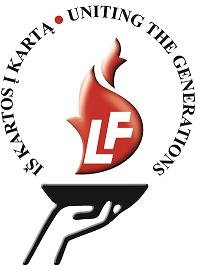

Leave a comment